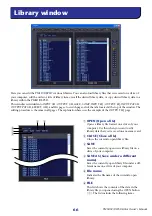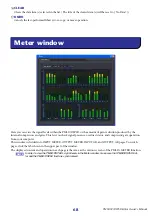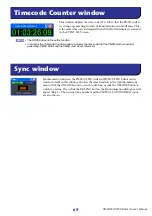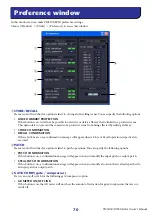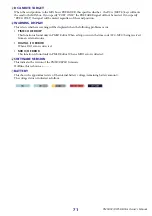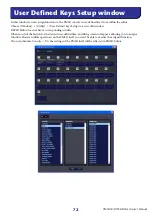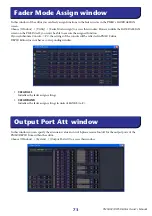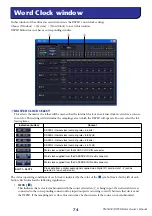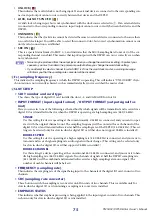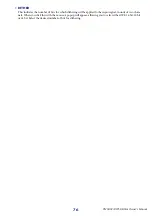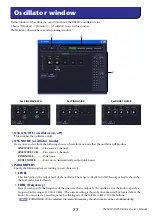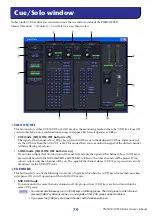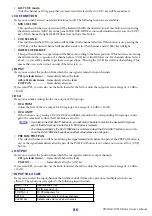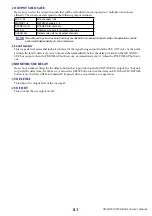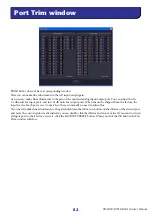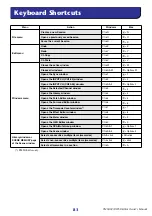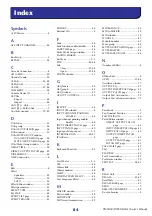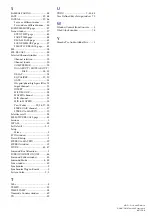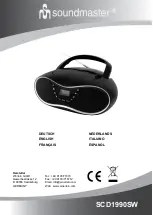
PM5DV2/DSP5D Editor Owner’s Manual
80
• LAST CUE mode
Only the channel or DCA group that was most recently selected by its [CUE] key will be monitored.
C
CUE FUNCTION
Here you can turn various cue-related functions on/off. The following functions are available.
• MIX CUE LINK
This specifies whether cue operation will be linked with MIX channel selection. If this button is on, pressing
the already-selected [MIX] key in the panel ENCODER MODE section will simultaneously cause the [CUE]
key of that channel to light. DSP5D Editor does not have this button.
• CUE/SEL LINK
This specifies whether CUE operation will be linked with channel selection. If this button is on, pressing the
[CUE] key of the desired channel will simultaneously select that channel, and its [SEL] key will light.
• FADER/CUE RELEASE
This specifies whether cue operation will be limited according to the fader position. If this button is on, raising
the fader from the –
∞
position of a channel whose [CUE] key is lit will defeat cue. For channels whose fader is
above –
∞
, you will be unable to perform cue operations. (Pressing the [CUE] key will not do anything.) This
means that cue can be turned on only if the fader is at –
∞
.
D
INPUT
Here you can select the position from which the cue signal is taken for input channels.
PFL (pre fader listen)
..... Immediately before the fader
AFL (after fader listen)
... Immediately after the fader
POST PAN
....................... Immediately after pan
If you select PFL, you can also use the knob located at the left to adjust the output level in a range of –20 dB to
+10 dB.
E
DCA
Here you can make settings for the cue output of DCA groups.
• DCA TRIM
Adjust the level of the cue output for DCA groups, in a range of –20 dB to +10 dB.
• DCA UNITY
If this button is on, pressing a DCA [CUE] key will always monitor the corresponding DCA group at unity
gain (the same level as when the DCA fader is at 0 dB).
• If you leave the DCA UNITY button on, you will always be able to monitor the desired DCA group
even if that DCA group is muted or if its DCA fader is lowered.
• The value specified by the DCA TRIM knob is valid even when the DCA UNITY button is on. (In this
case, the DCA TRIM knob specifies an offset value relative to unity gain.)
• PRE PAN/POST PAN
This selects whether you will be monitoring the signal immediately before the pan (if the PRE PAN button is
on) or the signal immediately after the pan (if the POST PAN button is on) when you turn on a DCA [CUE]
button.
F
OUTPUT
Here you can select the position from which the cue signal is taken for output channels.
PFL (pre fader listen)
..... Immediately before the fader
POST ON
......................... Immediately after the [ON] key
If you select PFL, you can also use the knob located at the left to adjust the output level in a range of –20 dB to
+10 dB.
G
INPUT SOLO SAFE
Here you can select the input channels that will be excluded from solo operations (multiple selections are
allowed). These buttons correspond to the following input channels.
INPUT 1–48
Input channels 1–48
ST IN 1–4
ST IN channels 1–4
FX RTN 1–4
FX RTN channels 1–4
SET ALL
Activates solo safe for all input channels
CLEAR ALL
Defeats solo safe for all input channels
HINT

